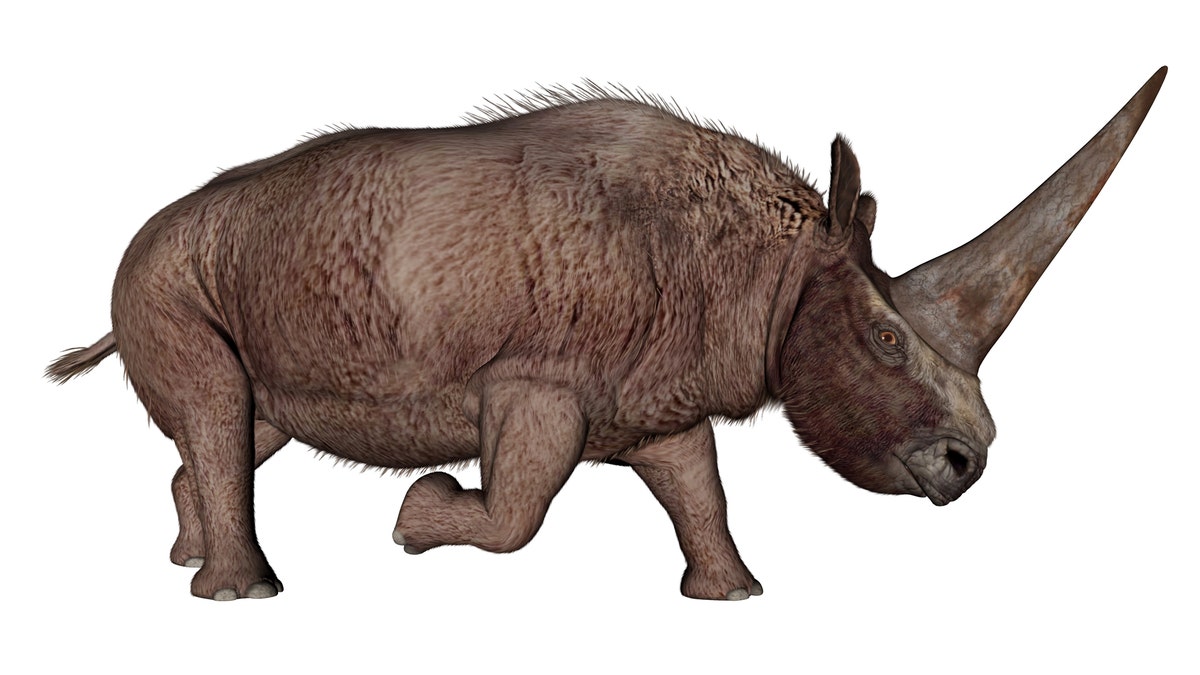
Elasmotherium dinosaur rhinoceros walking isolated in white background - 3D render (iStock)
Unicorns may be mythical creatures from ancient literature, but an ancient rhinoceros that was thought to have died out 200,000 years ago bears an eery resemblance to the legendary creature — and may have actually walked the Earth with modern-day humans.
Known as Elasmotherium sibiricum, this giant beast may have become extinct around 39,000 years ago, according to a new study published in Nature.
"Stable isotope data indicate a dry steppe niche for E. sibiricum and, together with morphology, a highly specialized diet that probably contributed to its extinction," the researchers wrote in the study. E. sibiricum is also known as the "Siberian unicorn," because of the large horn atop its head.
SCIENTISTS WANT TO CLONE THIS EXTINCT, FROZEN PREHISTORIC HORSE
E. sibiricum was enormous, at approximately 3.5 tons. By comparison, the white rhinoceros, the largest living rhino, weighs approximately 2.5 tons.
In addition to its size, its structure and shape was also "remarkable," the researchers noted: "relatively slender limbs indicating adaptation for running, despite its mass; absence of incisors and canines; and—uniquely among rhinoceroses—continuously growing cheek teeth with distinctive, highly convoluted enamel plates."
Its elongated horn, significantly larger than other rhinos, may be the result of a "bony protuberance on the frontal bone of the skull, which implies a horn base much larger than in any other rhinoceros, living or extinct," the researchers added.
"E. sibiricum was thought to have become extinct by 200,000 years ago, although recent, unconfirmed reports suggested that it might have persisted into the late Pleistocene, the researchers wrote in the study. "Its ecological niche has been a matter of speculation, from grazing on dry steppes to foraging for roots in damp riverine environments."
The researchers, led by study co-author Adrian Lister, looked at 25 bone samples and found 23 were able to be analyzed using radiocarbon dating because there was enough collagen left in them. Based on the data, Lister and the other researchers were able to determine that the species was still living in Europe and Asia approximately 39,000 years ago, along with modern humans.
The earliest homo sapien fossils outside of Africa have been carbon dated to approximately 177,000 years, according to a January 2018 study in the journal Science.
E. sibiricum is thought to have inhabited areas such as Kazakhstan, western and central Russia, Ukraine, Azerbaijan and Uzbekistan, and certain areas in Mongolia and China, though that may be more closely associated with E. caucasicum, another genus of rhinoceros.
CAN THE LONG-EXTINCT WOOLLY MAMMOTH BE CLONED?
Speaking with LiveScience, Ross MacPhee, a curator with the Department of Mammalogy at the American Museum of Natural History, said it's possible that these creatures lived even longer than believed, given the scarcity of their fossils.
"Rhino fossils are comparatively rare — they're not at all like wooly mammoths or bison in Siberia — and the fewer specimens you have, the less certain you can be," MacPhee told the publication. "You don't really know where you are, with respect to the 'life cycle' of the species."
Follow Chris Ciaccia on Twitter @Chris_Ciaccia




















